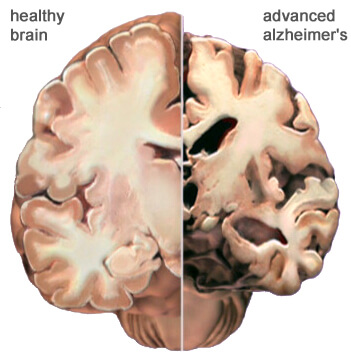

The Alzheimer’s Disease is when there is partial or total loss of memory. There is still no cure for this disease but there is a medication that can slower the stages. Alzheimer is most common on older people when your are 65 years old the probabilities get higher. this are some common symptoms of Alzheimer disease.
“Common symptoms of Alzheimer’s disease include:
- Impaired memory and thinking — The person has difficulty remembering things or learning new information. Long-term memory loss occurs when the person can’t remember personal information, such as his or her place of birth or occupation.
- Disorientation and confusion — People with Alzheimer’s disease might get lost when out on their own, and might not
 be able to remember where they are or how they got there. They also might not recognize previously familiar places and situations.
be able to remember where they are or how they got there. They also might not recognize previously familiar places and situations. - Misplacing things — The person forgets where he or she put things used every day, such as glasses, hearing aids, keys, etc. The person also might put things in strange places, such as leaving their glasses in the refrigerator.
- Abstract thinking — People with Alzheimer’s disease might find certain tasks—such as balancing a checkbook—more difficult than usual. For example, they might forget what the numbers mean and what needs to be done with them.
- Trouble performing familiar tasks — The person begins to have difficulty performing daily tasks, such as eating, dressing, and grooming.
- Changes in personality and behavior — The person becomes unusually angry, irritable, restless, or quiet.
- Poor or decreased judgment — The person has difficulty making decisions and cannot grasp consequences.
- Inability to follow directions — The person has difficulty understanding simple commands or directions. The person might get lost easily and begin to wander.
- Problems with language and communication — The person can’t recall words or understand the meaning of common words.
- Impaired visuospatial skills — The person loses spatial abilities (the ability to judge shapes and sizes, and the relation of objects in space), and can’t arrange items in a certain order or recognize shapes.
- Social withdrawal — The person begins to spend more time alone and is less willing to interact with others.
- Loss of motivation or initiative — The person might become very passive and require prompting to become involved.” (http://my.clevelandclinic.org/disorders/Alzheimers_Disease/hic_Symptoms_of_Alzheimers_Disease.aspx)
The video we saw in class showed the different stages that this dieaseas has. the first stage was a woman that was diagnose 2 month’s ago and se ant remember who was the president before Bush, she explains that se meets people and interacts which them but 10 min later she can’t remember their name. Later there is an example of another older woman that she wants to drive but really she cant remember the traffic sign’s, we also see an example of a old man who was a TV presenter and he died because of this ideas, he alusinated that he was in the TV show and we saw how he died.


